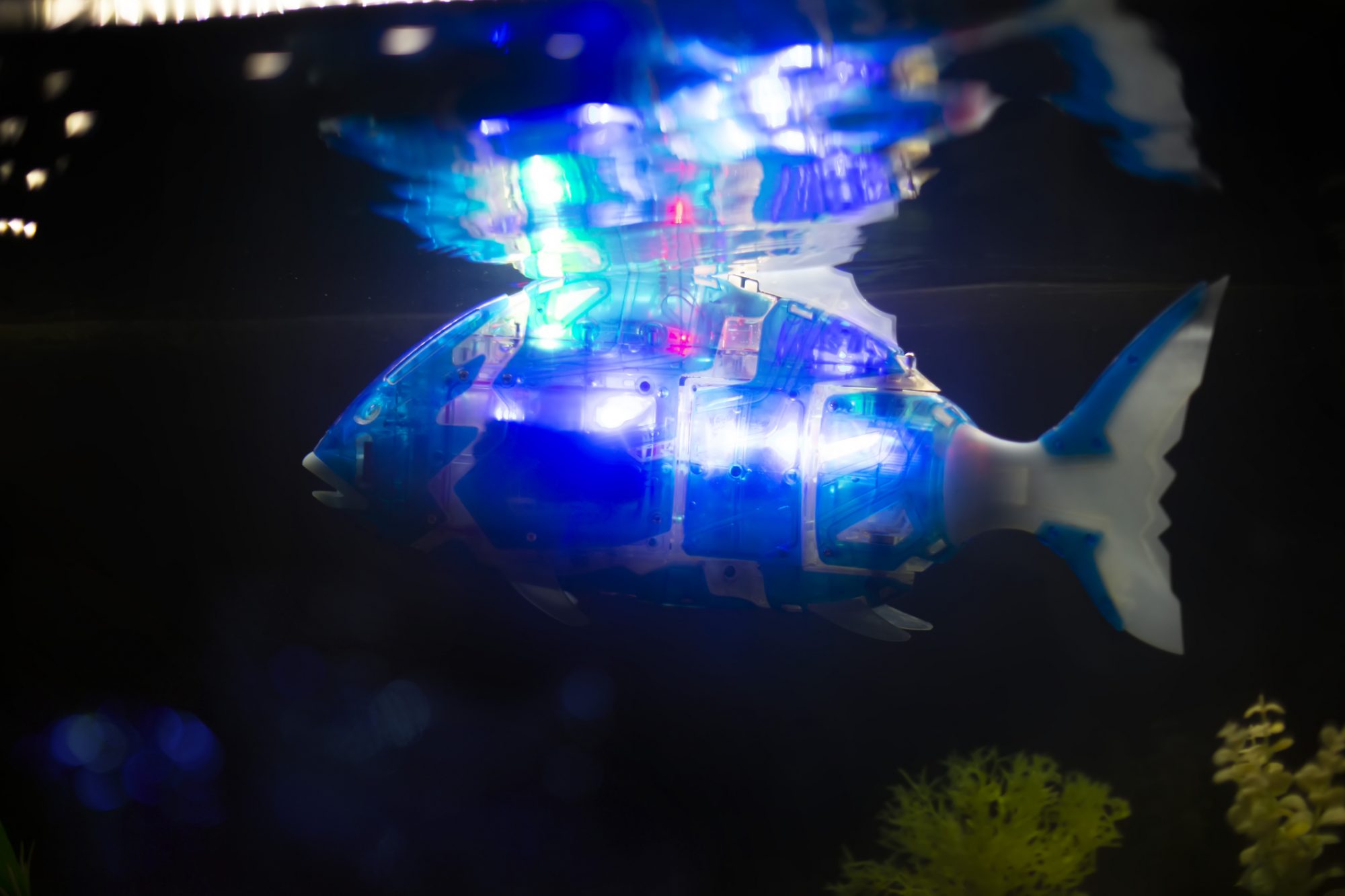Imagine a fish no bigger than your thumbnail swimming through polluted waters, methodically hunting down invisible enemies that threaten marine life worldwide. This isn’t science fiction—it’s the latest breakthrough from researchers who have created something that sounds too incredible to be real: a robotic fish that actively seeks out and collects microplastic pollution while possessing the remarkable ability to heal itself when damaged.
At just 13 millimeters long, this tiny artificial swimmer represents a quantum leap in environmental cleanup technology. What makes it truly extraordinary isn’t just its size or mission, but the revolutionary materials and engineering that allow it to function in ways that challenge everything we thought we knew about robotics and environmental remediation.
The implications extend far beyond a single small robot. This breakthrough could signal the beginning of an entirely new approach to tackling one of the 21st century’s most insidious environmental threats—one that infiltrates our food, water, and even our bloodstream without us ever realizing it.
The Invisible Enemy Choking Our Planet
Every plastic water bottle, synthetic t-shirt, car tire, and takeout container eventually breaks down into microscopic fragments that slip silently into our environment. These microplastics—particles smaller than 5 millimeters—have become one of the most pervasive pollutants on Earth, with billions of tiny fragments now floating in every ocean, river, and waterway.
Unlike larger plastic debris that we can see and collect, microplastics operate as invisible infiltrators. They’re too small for traditional cleanup methods but large enough to cause severe damage as they accumulate in marine food chains and eventually make their way into human bodies through drinking water and food consumption.
The scale of contamination is staggering. These microscopic fragments have been found everywhere from the deepest ocean trenches to the highest mountain peaks, from remote Arctic ice to the placentas of unborn babies. Once dispersed into the environment, they become virtually impossible to remove using conventional methods—until now.
Current approaches to plastic cleanup primarily focus on larger debris, leaving microscopic pollution to accumulate unchecked. The challenge has been developing technology sophisticated enough to target individual particles while robust enough to operate in harsh ocean conditions.
Nature’s Blueprint: Learning from Mother-of-Pearl

The breakthrough came when researchers looked to nature for inspiration, specifically to the iridescent interior of clam shells known as nacre or mother-of-pearl. This remarkable natural material combines incredible strength with flexibility through a unique layered structure that gradually transitions from calcium carbonate on one side to silk protein on the other.
Scientists from Sichuan University in China, collaborating with German colleagues, discovered that nacre’s gradient nanostructure holds the key to creating materials that can survive ocean conditions while maintaining the delicate properties required for microplastic collection. By mimicking nature’s engineering on a molecular level, they developed something entirely new.
“It is of great significance to develop a robot to accurately collect and sample detrimental microplastic pollutants from the aquatic environment,” explained Yuyan Wang, a researcher at the Polymer Research Institute of Sichuan University and lead author of the study. The team’s revolutionary approach represents the first successful attempt to create soft robots designed explicitly for this environmental mission.
The researchers created their bio-inspired material by layering microscopic sheets of molecules according to nacre’s specific chemical gradient, resulting in a substance that combines the best properties of natural and synthetic materials.
Meet the World’s First Plastic-Hunting Robot Fish

The resulting robo-fish measures just 13 millimeters in length—roughly half the size of a penny—but packs extraordinary capabilities into its tiny frame. Powered by a near-infrared laser system positioned at its tail, the robot swims by flapping its body segments at speeds of up to 30 millimeters per second, closely mimicking the movement patterns of plankton drifting through water.
This speed calculation reveals impressive engineering: the robot can move at 2.67 body lengths per second, a performance that matches or exceeds that of most artificial soft robots, allowing it to navigate effectively through water currents while maintaining precise control over its movement patterns.
The fish’s propulsion system represents a significant advancement in the field of soft robotics. Rather than relying on traditional motors or batteries that would add bulk and complexity, the laser activation system provides precise control while maintaining the robot’s streamlined profile and flexibility.
The swimming motion isn’t just about transportation—it’s carefully designed to maximize contact with potential microplastic particles while maintaining the robot’s structural integrity in varying water conditions.
The Science Behind the Synthetic Swimmer
At the molecular level, the robot fish consists of an elastomer actuator built with sulfonated graphene-based gradient nanostructures. This complex material achieves an ultrahigh toughness rating of 141.19 MJ/m³, making it remarkably resilient for such a small device while retaining the flexibility essential for its swimming motion.
The secret lies in how the material’s structure creates strong chemical bonds and electrostatic interactions with common microplastic pollutants. Organic dyes, antibiotics, and heavy metals commonly found in microplastic particles are naturally attracted to the robot’s surface materials, causing them to adhere as the fish swims through contaminated water.
This attraction mechanism works continuously as the robot moves, essentially turning its entire body surface into a collection device. Unlike mechanical filtration systems, which can clog or require maintenance, the robot’s chemical attraction approach enables it to operate efficiently for extended periods.
The graphene-based construction also provides excellent conductivity and heat tolerance, enabling the robot to function in various temperature conditions while maintaining its responsiveness to the laser control system.
Self-Healing Superpowers: The Wolverine of Robots

Perhaps the most remarkable feature of this robotic fish is its ability to repair itself when damaged. The nanocomposite material exhibits an 89% self-healing efficiency at room temperature, allowing cuts, tears, or other damage to be automatically restored without external intervention.
This self-healing capability addresses one of the biggest challenges in deploying robots in ocean environments. Rocky coastlines, debris fields, and rough waters can quickly damage conventional robotic systems, requiring expensive retrieval and repair operations that make large-scale deployment impractical.
The healing process occurs through the reformation of molecular bonds within the material structure. When damage occurs, the material’s chemical properties allow it to gradually restore its original configuration, maintaining both structural integrity and functional capabilities.
“To the best of our knowledge, this is the first example of such soft robots,” Wang noted, emphasizing how this combination of pollution collection and self-repair capabilities represents an entirely new category of environmental technology.
The Plastic Collection Process
The robot fish operates as a living magnet for microplastic pollutants, but instead of relying on magnetic attraction, it utilizes precisely engineered chemical interactions. As the fish swims through contaminated water, microplastic particles containing organic dyes, antibiotics, and heavy metals are drawn to its surface through strong chemical bonds and electrostatic forces.
Once particles adhere to the robot’s surface, they remain trapped, allowing the fish to accumulate substantial amounts of microplastic material relative to its size. The collection process is passive but highly effective, requiring no additional energy beyond the swimming motion itself.
After collection missions, researchers can retrieve the robots and analyze the accumulated microplastics to understand the composition and concentration of pollution in specific areas. “After the robot collects the microplastics in the water, the researchers can further analyze the composition and physiological toxicity of the microplastics,” Wang explained.
This analytical capability transforms the robots from simple collection devices into sophisticated environmental monitoring tools that can provide detailed data about pollution sources, chemical composition, and concentration levels across different locations and depths.
Strength in Small Packages: Impressive Physical Capabilities

Despite its diminutive size, the robot fish demonstrates surprising physical capabilities that extend well beyond swimming and plastic collection. Laboratory tests revealed that individual robots could lift weights of up to 5 kilograms—more than 300,000 times their body weight—while maintaining their flexibility and range of motion.
The material’s exceptional properties allow the robots to stretch, twist, and bend without losing functionality, making them adaptable to various ocean conditions and deployment scenarios. High-temperature tolerance ensures continued operation in different climatic conditions, from tropical waters to more temperate environments.
These physical capabilities suggest potential applications beyond microplastic collection, including deployment as environmental sensors, water quality monitors, or components in larger ocean cleanup systems where their small size and durability could provide significant advantages.
The strength-to-weight ratio achieved by the bio-inspired design surpasses many conventional materials, demonstrating how biomimetic approaches can lead to performance improvements across multiple engineering parameters simultaneously.
The Bigger Picture: Nanotechnology vs. Plastic Pollution

The robot fish represents one approach in a broader scientific campaign against plastic pollution that combines cleanup technologies with prevention strategies. Philip Demokritou, director of the Nanoscience and Advanced Materials Research Center at Rutgers University, advocates for a multi-pronged approach that addresses both existing pollution and future plastic production.
Demokritou’s team focuses on developing environmentally friendly alternatives to plastic packaging, including plant-based spray coatings that can replace plastic food wraps. This prevention-focused approach complements cleanup technologies, such as the robot fish, by reducing the future influx of materials that eventually become microplastic pollution.
The distinction between invention and practical application remains crucial for all these technologies. As Demokritou notes, true innovation requires scaling laboratory breakthroughs into commercially viable solutions that can meaningfully impact global pollution levels.
Nanotechnology applications in environmental remediation continue to expand, offering hope for addressing pollution challenges that seemed insurmountable just a few decades ago.
Swimming Toward a Cleaner Future
The development of self-healing, plastic-collecting robot fish represents a significant milestone in environmental technology, demonstrating how bio-inspired design can address complex ecological challenges. While current limitations prevent immediate large-scale deployment, the fundamental breakthroughs in materials science and robotic engineering provide a foundation for continued advancement.
As microplastic pollution continues accumulating in marine environments worldwide, innovative solutions like robot fish offer hope that human ingenuity can develop technologies capable of addressing the environmental challenges we’ve created. The marriage of natural inspiration and advanced materials science points toward a future where cleanup operations could be as persistent and adaptable as the pollution they’re designed to eliminate.
The tiny robot fish swimming in laboratory tanks today might herald tomorrow’s autonomous cleanup fleets, working tirelessly to restore ocean health one microscopic particle at a time.














Leave a Reply